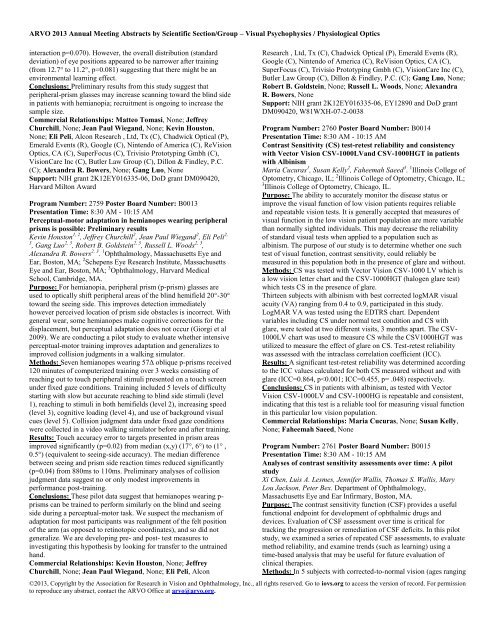Visual Psychophysics / Physiological Optics - ARVO
Visual Psychophysics / Physiological Optics - ARVO
Visual Psychophysics / Physiological Optics - ARVO
Create successful ePaper yourself
Turn your PDF publications into a flip-book with our unique Google optimized e-Paper software.
<strong>ARVO</strong> 2013 Annual Meeting Abstracts by Scientific Section/Group – <strong>Visual</strong> <strong>Psychophysics</strong> / <strong>Physiological</strong> <strong>Optics</strong>interaction p=0.070). However, the overall distribution (standarddeviation) of eye positions appeared to be narrower after training(from 12.7° to 11.2°, p=0.081) suggesting that there might be anenvironmental learning effect.Conclusions: Preliminary results from this study suggest thatperipheral-prism glasses may increase scanning toward the blind sidein patients with hemianopia; recruitment is ongoing to increase thesample size.Commercial Relationships: Matteo Tomasi, None; JeffreyChurchill, None; Jean Paul Wiegand, None; Kevin Houston,None; Eli Peli, Alcon Research , Ltd, Tx (C), Chadwick Optical (P),Emerald Events (R), Google (C), Nintendo of America (C), ReVision<strong>Optics</strong>, CA (C), SuperFocus (C), Trivisio Prototyping Gmbh (C),VisionCare Inc (C), Butler Law Group (C), Dillon & Findley, P.C.(C); Alexandra R. Bowers, None; Gang Luo, NoneSupport: NIH grant 2K12EY016335-06, DoD grant DM090420,Harvard Milton AwardProgram Number: 2759 Poster Board Number: B0013Presentation Time: 8:30 AM - 10:15 AMPerceptual-motor adaptation in hemianopes wearing peripheralprisms is possible: Preliminary resultsKevin Houston 1, 2 , Jeffrey Churchill 2 , Jean Paul Wiegand 2 , Eli Peli 2,3 , Gang Luo 2, 3 , Robert B. Goldstein 2, 3 , Russell L. Woods 2, 3 ,Alexandra R. Bowers 2, 3 . 1 Ophthalmology, Massachusetts Eye andEar, Boston, MA; 2 Schepens Eye Research Institute, MassachusettsEye and Ear, Boston, MA; 3 Ophthalmology, Harvard MedicalSchool, Cambridge, MA.Purpose: For hemianopia, peripheral prism (p-prism) glasses areused to optically shift peripheral areas of the blind hemifield 20°-30°toward the seeing side. This improves detection immediatelyhowever perceived location of prism side obstacles is incorrect. Withgeneral wear, some hemianopes make cognitive corrections for thedisplacement, but perceptual adaptation does not occur (Giorgi et al2009). We are conducting a pilot study to evaluate whether intensiveperceptual-motor training improves adaptation and generalizes toimproved collision judgments in a walking simulator.Methods: Seven hemianopes wearing 57Δ oblique p-prisms received120 minutes of computerized training over 3 weeks consisting ofreaching out to touch peripheral stimuli presented on a touch screenunder fixed gaze conditions. Training included 5 levels of difficultystarting with slow but accurate reaching to blind side stimuli (level1), reaching to stimuli in both hemifields (level 2), increasing speed(level 3), cognitive loading (level 4), and use of background visualcues (level 5). Collision judgment data under fixed gaze conditionswere collected in a video walking simulator before and after training.Results: Touch accuracy error to targets presented in prism areasimproved significantly (p=0.02) from median (x,y) (17°, 6°) to (1° ,0.5°) (equivalent to seeing-side accuracy). The median differencebetween seeing and prism side reaction times reduced significantly(p=0.04) from 880ms to 110ms. Preliminary analyses of collisionjudgment data suggest no or only modest improvements inperformance post-training.Conclusions: These pilot data suggest that hemianopes wearing p-prisms can be trained to perform similarly on the blind and seeingside during a perceptual-motor task. We suspect the mechanism ofadaptation for most participants was realignment of the felt positionof the arm (as opposed to retinotopic coordinates), and so did notgeneralize. We are developing pre- and post- test measures toinvestigating this hypothesis by looking for transfer to the untrainedhand.Commercial Relationships: Kevin Houston, None; JeffreyChurchill, None; Jean Paul Wiegand, None; Eli Peli, AlconResearch , Ltd, Tx (C), Chadwick Optical (P), Emerald Events (R),Google (C), Nintendo of America (C), ReVision <strong>Optics</strong>, CA (C),SuperFocus (C), Trivisio Prototyping Gmbh (C), VisionCare Inc (C),Butler Law Group (C), Dillon & Findley, P.C. (C); Gang Luo, None;Robert B. Goldstein, None; Russell L. Woods, None; AlexandraR. Bowers, NoneSupport: NIH grant 2K12EY016335-06, EY12890 and DoD grantDM090420, W81WXH-07-2-0038Program Number: 2760 Poster Board Number: B0014Presentation Time: 8:30 AM - 10:15 AMContrast Sensitivity (CS) test-retest reliability and consistencywith Vector Vision CSV-1000LVand CSV-1000HGT in patientswith AlbinismMaria Cucuras 1 , Susan Kelly 2 , Faheemah Saeed 3 . 1 Illinois College ofOptometry, Chicago, IL; 2 Illinois College of Optometry, Chicago, IL;3 Illinois College of Optometry, Chicago, IL.Purpose: The ability to accurately monitor the disease status orimprove the visual function of low vision patients requires reliableand repeatable vision tests. It is generally accepted that measures ofvisual function in the low vision patient population are more variablethan normally sighted individuals. This may decrease the reliabilityof standard visual tests when applied to a population such asalbinism. The purpose of our study is to determine whether one suchtest of visual function, contrast sensitivity, could reliably bemeasured in this population both in the presence of glare and without.Methods: CS was tested with Vector Vision CSV-1000 LV which isa low vision letter chart and the CSV-1000HGT (halogen glare test)which tests CS in the presence of glare.Thirteen subjects with albinism with best corrected logMAR visualacuity (VA) ranging from 0.4 to 0.9, participated in this study.LogMAR VA was tested using the EDTRS chart. Dependentvariables including CS under normal test condition and CS withglare, were tested at two different visits, 3 months apart. The CSV-1000LV chart was used to measure CS while the CSV1000HGT wasutilized to measure the effect of glare on CS. Test-retest reliabilitywas assessed with the intraclass correlation coefficient (ICC).Results: A significant test-retest reliability was determined accordingto the ICC values calculated for both CS measured without and withglare (ICC=0.864, p
















